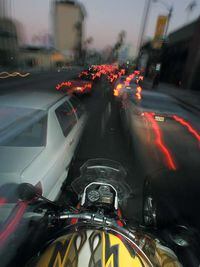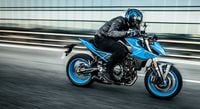The American Motorcycle Association (AMA) has confirmed that bill S.B. 350, which would have restricted the common practice of lane-splitting by California motorcyclists would be withdrawn from consideration. This is good news for many California motorcyclists who employ the practice recognized by the California Highway Patrol as an important means to help ease traffic flow.
The bill, introduced Feb. 20 by Sen. Jim Beall (D-San Jose), would have restricted lane-splitting to certain instances: on [divided highways with three or more lanes of travel in the same direction, only when traffic is congested, and only at a “safe speed.”
Nick Haris, AMA western states representative, noted that lane-splitting has been an accepted custom and necessary strategy to ease traffic congestion in California for years. He noted that Beall's bill proposed a sudden and significant shift in traffic management strategies in the state with respect to motorcycles, which could have had a serious impact on traffic flow.
According to the California Highway Patrol, lane-splitting occurs when a motorcyclist rides between lanes of stopped or slower-moving traffic or moves between lanes to the front of stopped traffic. The convention is recognized as a benefit to urban traffic flow because it allows motorcycles to make maximum use of roadways when traffic is stopped or significantly slowed. The controlled flow of motorcyclists through stopped traffic also permits more space for other road users.
"We are pleased that Sen. Beall's office is withdrawing the bill, but we remain watchful of any legislative action on lane-splitting that could penalize motorcyclists," Haris said. "Lane-splitting has been done safely in California for decades, so there is really no need to impose new restrictions, especially given the guidelines just released by the California Highway Patrol that make no mention of a three-lane minimum."


/cloudfront-us-east-1.images.arcpublishing.com/octane/7OWQWAWJBFCGTAYQWBMWGNMNB4.jpg)
/cloudfront-us-east-1.images.arcpublishing.com/octane/4G5XKCDIHRCGRHVF7OPORG7ZX4.jpg)
/cloudfront-us-east-1.images.arcpublishing.com/octane/D2BDYKKNZ5GRHGDMI4PZTGRMME.jpg)

/cloudfront-us-east-1.images.arcpublishing.com/octane/UAY4WSZPOFDQRP4MCEXAKDFQOQ.jpg)

/cloudfront-us-east-1.images.arcpublishing.com/octane/X5CE3KSJHZHM5CUFGPZ7U26WB4.jpg)
/cloudfront-us-east-1.images.arcpublishing.com/octane/COWLTPGFAFGDDGJCTENYMA4VJM.jpg)
/cloudfront-us-east-1.images.arcpublishing.com/octane/H3PKUGPSUJFTND4RFPSI4OIDCE.jpg)
/cloudfront-us-east-1.images.arcpublishing.com/octane/UHGQA3MQDFCA3HLBWF7S76WH6Y.jpg)
/cloudfront-us-east-1.images.arcpublishing.com/octane/Q5EORCSTNFAVBJC4IYUHIKJTXQ.jpg)
/cloudfront-us-east-1.images.arcpublishing.com/octane/XIJ5FUFSP5A3NL7MOVZGJXAHC4.jpg)
/cloudfront-us-east-1.images.arcpublishing.com/octane/V5NZN3CGS5B5PPYFYJHIPAU5S4.jpg)
/cloudfront-us-east-1.images.arcpublishing.com/octane/CZE6ONOBU5E7HPIEEADU376C4M.jpg)
/cloudfront-us-east-1.images.arcpublishing.com/octane/UT4KL3SIYJBSPNHWJXTBE6MTGE.jpg)
/cloudfront-us-east-1.images.arcpublishing.com/octane/Q3UOIDZ22ZEVDBZUWGJXIMGJKI.jpg)
/cloudfront-us-east-1.images.arcpublishing.com/octane/YQM66WXZV5AAXNNOIUVOGVXZMY.jpg)
/cloudfront-us-east-1.images.arcpublishing.com/octane/J47NFTXNLFFGHELHZCUD2LCITA.jpg)
/cloudfront-us-east-1.images.arcpublishing.com/octane/NXPQBTLX3NCILKQ2GCFJYNIDEM.jpg)
/cloudfront-us-east-1.images.arcpublishing.com/octane/6U7NJLAYMRBZTIGNKWIA5OK2FQ.jpg)
/cloudfront-us-east-1.images.arcpublishing.com/octane/IYTZQWUROVC25IMTDEWUDQ5IQE.jpg)
/cloudfront-us-east-1.images.arcpublishing.com/octane/YJODDXEL2ZB5TENKPPN4BEYJAE.jpg)
/cloudfront-us-east-1.images.arcpublishing.com/octane/QEQQUZYNJFAIJB4DZFVFSNTCQ4.jpg)
/cloudfront-us-east-1.images.arcpublishing.com/octane/F4EEHDT3UZFKPLKVGDWMMPFEQE.jpg)